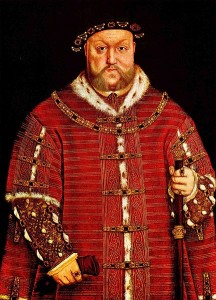How Henry VIII’s Racy Sex Life Turned Me into An Archaeological Writer
by Heather Pringle
July 30, 2010
 Yesterday, British blogger Ed Yong put out a call in cyberspace asking science writers to fess up publicly to how they had arrived at their chosen line of work. As you can see over at Not Exactly Rocket Science, dozens of my colleagues began instantly pounding their keyboards: within 9 hours, Yong had 49 responses. New York writer Carl Zimmer said he’d lucked into the job thanks to a stint he did as a fact-checker at Discover magazine: Steve Silberman traced his love of science to, among other things, blowing stuff up with a childhood chemistry set.
Yesterday, British blogger Ed Yong put out a call in cyberspace asking science writers to fess up publicly to how they had arrived at their chosen line of work. As you can see over at Not Exactly Rocket Science, dozens of my colleagues began instantly pounding their keyboards: within 9 hours, Yong had 49 responses. New York writer Carl Zimmer said he’d lucked into the job thanks to a stint he did as a fact-checker at Discover magazine: Steve Silberman traced his love of science to, among other things, blowing stuff up with a childhood chemistry set.
In the spirit of these disclosures, Â I thought I’d divulge how it was that I became an archaeological writer. I wish I could point to something really glorious, say a brilliant grade-five school project in which I learned to recreate the Elgin Marbles with just toothpicks and Wite-out. Or that I spent my summers as a child in the south of France, Â mastering Mousterian flint-knapping.
But the truth is considerably more humble. I grew up in an oil-boom city in northern Alberta where all the architecture looked as if it had just been shaken loose from packing crates. Everything was bright and new and oh so determinedly modern. Â There wasn’t a single building standing in my home city that dated back more than 100 years. As a result, Â I grew up thinking that Alberta had very little history, and no prehistory at all.
I loved to read, however, and I was fascinated by the past. And as a young teenager, I stumbled upon the shelves of historical novels in a little local library, and began hungrily quaffing these books down. Before long, I had devoured stacks of novels on Tudor England (I particularly loved Henry VIII’s complicated  sex life), Renaissance Italy, ancient Egypt, classical Rome, and classical Greece.  I read just about every book Mary Renault ever wrote.
I didn’t know it at the time, but many these novels were often thinly disguised social histories, lovingly detailed tableaus of  royal court life, say, or ancient Greek temples. At university, I majored in history and studied English literature, particularly Victorian novels, with their detailed portraits of 19th century British life. When I finally graduated, I snagged one of the coolest jobs on the planet–as a research assistant in the history department of a major museum.
As historical archaeologists know, it’s a very small jump from history to archaeology and when I finally began freelance writing in the early 80s, I gravitated to writing about archaeology: I’ve never looked back. Â I guess the conclusion to be be drawn from all of this is that there is no set career path to becoming a science writer. Â Nearly any road can lead to Rome.
Today, after nearly three decades of laboring in the trenches (literally and figuratively) as a archaeological writer,  my view of the world has changed radically. I now see invisible worlds–of the Minoans when I walk in Crete, the Nasca when I drive the Pan-American, and the Lapita people when I fly over the turquoise waters of the  South Pacific.
I know now that Alberta has a long and rich prehistory, stretching back nearly 11,000 years. Thank you, Mary Renault. Â Thank you, Henry VIII, Â for opening my eyes.
Comments posted here do not represent the views or policies of the Archaeological Institute of America.






 Heather Pringle is a freelance science journalist who has been writing about archaeology for more than 20 years. She is the author of Master Plan: Himmler's Scholars and the Holocaust and The Mummy Congress: Science, Obsession, and the Everlasting Dead. For more about Heather, see our
Heather Pringle is a freelance science journalist who has been writing about archaeology for more than 20 years. She is the author of Master Plan: Himmler's Scholars and the Holocaust and The Mummy Congress: Science, Obsession, and the Everlasting Dead. For more about Heather, see our 



